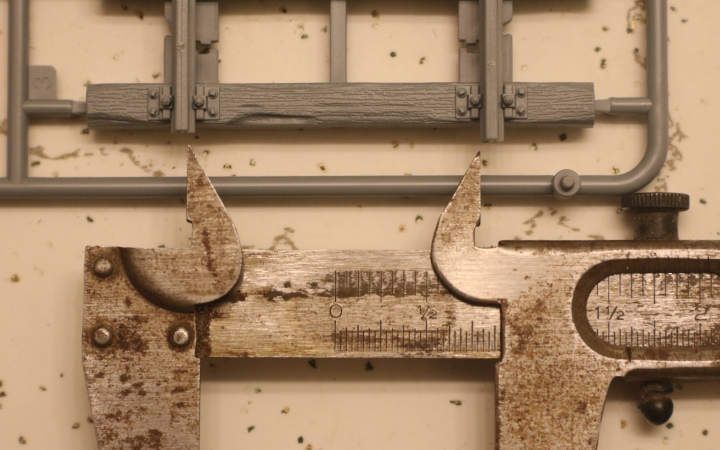It is a great idea although gauge may be an issue. The Soviet and German gauges were different. These are the most commonly produced items so for. Having two, at least, will be an issue. HO and HOn3 are different ones currently in use in the mainstream model railroading. I hope there would be some way of approaching this.
Site Talk
Site announcements, comments, or feedback about the site.
Site announcements, comments, or feedback about the site.
Hosted by Darren Baker, Jim Starkweather
"Military Scale" for Railroad Models?
alanJackson

Joined: November 16, 2019
KitMaker: 2 posts
Armorama: 2 posts

Posted: Saturday, November 16, 2019 - 06:27 AM UTC

RobinNilsson

Joined: November 29, 2006
KitMaker: 6,693 posts
Armorama: 5,562 posts

Posted: Sunday, November 17, 2019 - 02:30 AM UTC
Quoted Text
......
F.Y.I. - I read the Sabre track as having a gauge of 43mm. (That's more than a bit off if you ask me.)
Additionally; the Sabre rail appears to be of a much lighter weight (smaller) code rail.
......
I measured the Sabre track to slightly more than 41 mm.
Height of rail is 4 mm
Sleeper width is 6 mm
/ Robin
Removed by original poster on 11/17/19 - 16:20:22 (GMT).

RobinNilsson

Joined: November 29, 2006
KitMaker: 6,693 posts
Armorama: 5,562 posts

Posted: Sunday, November 17, 2019 - 03:26 AM UTC
I snipped the two rails loose and measured between the insides of the flanges. The plates under tha rails slope slightly inwards so the rails lean inwards.
By measuring with your method you get a center-to-center distance, not flange inside to flange inside.
Consider this schematic: _T___T_
You measured the distance between the center of the stems of the T's.
The gauge is between the right edge of the top bar of the left T to the left edge of the top bar of the right T. The difference in distance equals the length of the top bar of one T.
Cheers / Robin
By measuring with your method you get a center-to-center distance, not flange inside to flange inside.
Consider this schematic: _T___T_
You measured the distance between the center of the stems of the T's.
The gauge is between the right edge of the top bar of the left T to the left edge of the top bar of the right T. The difference in distance equals the length of the top bar of one T.
Cheers / Robin
Posted: Sunday, November 17, 2019 - 04:32 AM UTC
OK, my Bad!
I now see what I was doing wrong! My method of measurement gave me the distance NOT of the gauge. It was giving me the distant from the inside of one rail to the OUTSIDE of the other rail.
I am now on the same page with Robin. I went ahead and assembled the Sabre track and came up with a gauge of just slightly more than 41mm, matching exactly what Robin discovered. A much better result!

(The above photo is a representative photo only. It does not illustrate the taking of the actual measurement.)
Again, MY BAD - Sorry!
I now see what I was doing wrong! My method of measurement gave me the distance NOT of the gauge. It was giving me the distant from the inside of one rail to the OUTSIDE of the other rail.
I am now on the same page with Robin. I went ahead and assembled the Sabre track and came up with a gauge of just slightly more than 41mm, matching exactly what Robin discovered. A much better result!

(The above photo is a representative photo only. It does not illustrate the taking of the actual measurement.)
Again, MY BAD - Sorry!
Posted: Sunday, November 17, 2019 - 05:02 AM UTC
Robin you are again correct that the tie plates on the Sabre track are designed to force the rail to lean inward almost imperceivably - a very interesting and unique solution!

RobinNilsson

Joined: November 29, 2006
KitMaker: 6,693 posts
Armorama: 5,562 posts

Posted: Sunday, November 17, 2019 - 05:18 AM UTC
I assume that you have heard/read the tale (truth value very uncertain) about the Russian Czars spies who measured tge rail gauge in France and reported the measured value.
The Russian rail gauge was then defined accordingly.
But why is it wider than the European gauge?
The spies measured the distance between the outside edges of the rails....
The angled plates are copied from the 1:1 rails:
"Tie plates
A tie plate, baseplate or sole plate is a steel plate used on rail tracks between flanged T rail and the crossties. The tie plate increases bearing area and holds the rail to correct gauge. They are fastened to wooden ties by means of spikes or bolts through holes in the plate.
The part of the plate under the rail base is tapered, setting the cant of the rail, an inward rotation from the vertical. The usual slope is one in forty ( 1.4 degrees ). The top surface of the plate has one or two shoulders that fit against the edges of the base of the rail. The double-shoulder type is currently used. Older single-shoulder types were adaptable for various rail widths, with the single shoulder positioned on the outside (field side) of the rails. Most plates are slightly wider on the field side, without which the plates tend to cut more into the outsides of the tie, reducing cant angle.
Many railways use large wood screws, also called lag screws, to fasten the tie plates (or baseplates) to the railroad ties.
Tie plates came into use around the year 1900, before which time flanged T rail was spiked directly to the ties. "
Further reading here, including the quote above:
https://en.wikipedia.org/wiki/Rail_fastening_system
/ Robin
P.S. Those calipers REALLY need some TLC. You could try buffing them with ketchup ....
The Russian rail gauge was then defined accordingly.
But why is it wider than the European gauge?
The spies measured the distance between the outside edges of the rails....
The angled plates are copied from the 1:1 rails:
"Tie plates
A tie plate, baseplate or sole plate is a steel plate used on rail tracks between flanged T rail and the crossties. The tie plate increases bearing area and holds the rail to correct gauge. They are fastened to wooden ties by means of spikes or bolts through holes in the plate.
The part of the plate under the rail base is tapered, setting the cant of the rail, an inward rotation from the vertical. The usual slope is one in forty ( 1.4 degrees ). The top surface of the plate has one or two shoulders that fit against the edges of the base of the rail. The double-shoulder type is currently used. Older single-shoulder types were adaptable for various rail widths, with the single shoulder positioned on the outside (field side) of the rails. Most plates are slightly wider on the field side, without which the plates tend to cut more into the outsides of the tie, reducing cant angle.
Many railways use large wood screws, also called lag screws, to fasten the tie plates (or baseplates) to the railroad ties.
Tie plates came into use around the year 1900, before which time flanged T rail was spiked directly to the ties. "
Further reading here, including the quote above:
https://en.wikipedia.org/wiki/Rail_fastening_system
/ Robin
P.S. Those calipers REALLY need some TLC. You could try buffing them with ketchup ....
Posted: Thursday, November 21, 2019 - 03:59 PM UTC
Quoted Text
It is a great idea although gauge may be an issue. The Soviet and German gauges were different. These are the most commonly produced items so for. Having two, at least, will be an issue. HO and HOn3 are different ones currently in use in the mainstream model railroading. I hope there would be some way of approaching this.
Hi Alan,
There is a way of approaching this. Declaring "Military Scale" to be 1/35 and 1/35 to be "Military Scale" is a bureaucratic title, but should stipulate model companies to be precise in scaling track/ties/fishplates, etc., at 1/35. That is regardless of whether the model track is standard gauge, broad gauge (Soviet), narrow gauge, etc. Just so long as a track gauge is standard regardless of manufacturer.
Where issues could arise is length and weight of rail. In US before ribbon rail, rails were made in 39-foot lengths. I don't know what length they were standardized in various European countries. But a little research should reveal lengths, i.e., Reichbahn rail was (just guessing here) 10 meters long.
"Weight" of rail is based (in US) on weight per yard. And there were a zillion weights over the decades. Correct me but I recall in US that WWII-era main line rail was 80-100lbs. Secondary and branch rail could be 40-70lbs. Weight of rail presents mainly in height.
Ultimately, it is irrelevant whether a model of "M scale" track is broad or standard or narrow gauge, so long as it is sized to 1/35, regardless of the gauge of track. Standard gauge 4' 8.5" is 52.5", which if my math is correct (probably isn't) is 19.3795mm. Soviet 5' broad gauge would be 20.58mm in 1/35.
BTW, this is useful. Fine Scale Modeler Understanding and converting scale ratios

SpeedyJ

Joined: September 17, 2013
KitMaker: 1,617 posts
Armorama: 1,150 posts

Posted: Thursday, November 21, 2019 - 04:32 PM UTC
A little correction on the length of DR tracks. Approx. 15 meter and later a 30 meter length was used. Sorry, the site is only in German...
https://www.hosentraeger-spur1.de/index.php/der-reichsbahnoberbau
All you ever wanted to know about tracks in Germany.
Robert Jan
https://www.hosentraeger-spur1.de/index.php/der-reichsbahnoberbau
All you ever wanted to know about tracks in Germany.
Robert Jan

Posted: Thursday, November 21, 2019 - 04:33 PM UTC
Quoted Text
The Russian rail gauge was then defined accordingly.
But why is it wider than the European gauge?
Hi Robin,
A few reasons. The wider the gauge, the greater the load-carrying capacity of a railroad, as well as stability of rolling stock. For a long time, New York state had a large network of 6-ft gauge railroads. Many railroads in the American South were 5' gauge. I recall gauges were mostly standardized to 4'8.5" c. 1886. India, Pakistan, and some South American countries "standardized" at 5' 6".
I recall Russia chose 5' for loading capacity.
Posted: Thursday, November 21, 2019 - 04:43 PM UTC
Hi Jan,
Thanks for that. 15 or 30m length? Interesting.
Here is Armor 35 German type S49 track. They made it as a 12m length.
Any idea what "S49" means?
Thanks for that. 15 or 30m length? Interesting.
Here is Armor 35 German type S49 track. They made it as a 12m length.
Any idea what "S49" means?


SpeedyJ

Joined: September 17, 2013
KitMaker: 1,617 posts
Armorama: 1,150 posts

Posted: Thursday, November 21, 2019 - 05:21 PM UTC
Hi Frederick,
S49 stands for the track profile. That is, again, applicable for European tracks, a standard set by the DR and still in use through all of Europe..
Will check for some more sources that explain the different profiles used and in use today.
Robert Jan
S49 stands for the track profile. That is, again, applicable for European tracks, a standard set by the DR and still in use through all of Europe..
Will check for some more sources that explain the different profiles used and in use today.
Robert Jan


SpeedyJ

Joined: September 17, 2013
KitMaker: 1,617 posts
Armorama: 1,150 posts

Posted: Thursday, November 21, 2019 - 05:54 PM UTC
Hello all.
From the site, in German, the information about the tracks and bedding is a story of standards set by the DR.
From the North to the South, from West to the East, Germany Railroads was a patch work of Companies with all kinds of systems, measures, materials used that worked. The standards set in the Mid Twenties, when all over Europe the small independent railroad companies merged to one National Railroad Company, introduced by the DR was the S49 track system / profile.
Material used for sleepers: steel - concrete - wood.
Just before the outbreak of WWII about 45% of the sleepers in use were made of steel and/or concrete.
If you read the diagrams from the site, you can see that measurements for sleeper distance are different.
You have slow tracks and high speed tracks, light rail and heavy rail.
The standards set were used to connect all the German states with a solid and state of the art modern system.
Connected to this, the Länderbahn (local country side track still had their old fashioned "romantic" system.
More to come later...
Robert Jan

From the site, in German, the information about the tracks and bedding is a story of standards set by the DR.
From the North to the South, from West to the East, Germany Railroads was a patch work of Companies with all kinds of systems, measures, materials used that worked. The standards set in the Mid Twenties, when all over Europe the small independent railroad companies merged to one National Railroad Company, introduced by the DR was the S49 track system / profile.
Material used for sleepers: steel - concrete - wood.
Just before the outbreak of WWII about 45% of the sleepers in use were made of steel and/or concrete.
If you read the diagrams from the site, you can see that measurements for sleeper distance are different.
You have slow tracks and high speed tracks, light rail and heavy rail.
The standards set were used to connect all the German states with a solid and state of the art modern system.
Connected to this, the Länderbahn (local country side track still had their old fashioned "romantic" system.
More to come later...
Robert Jan



RobinNilsson

Joined: November 29, 2006
KitMaker: 6,693 posts
Armorama: 5,562 posts

Posted: Thursday, November 21, 2019 - 09:40 PM UTC
Quoted Text
Quoted TextThe Russian rail gauge was then defined accordingly.
But why is it wider than the European gauge?
Hi Robin,
A few reasons. The wider the gauge, the greater the load-carrying capacity of a railroad, as well as stability of rolling stock. For a long time, New York state had a large network of 6-ft gauge railroads. Many railroads in the American South were 5' gauge. I recall gauges were mostly standardized to 4'8.5" c. 1886. India, Pakistan, and some South American countries "standardized" at 5' 6".
I recall Russia chose 5' for loading capacity.
The distance between the rails also affects the minimum radius for turns. Wider track => larger minimum radius.
/ Robin
 |














